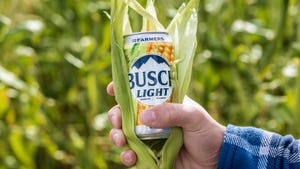Use Distillers Grains Futures For Risk Protection
Trying to get a handle on the market for distillers grains (DG) is not unlike throwing a houlihan loop at a coyote. The darn thing’s right in front of you, but with all the ducking and dodging, you can’t quite seem to make the catch

Trying to get a handle on the market for distillers grains (DG) is not unlike throwing a houlihan loop at a coyote. The darn thing’s right in front of you, but with all the ducking and dodging, you can’t quite seem to make the catch.
Thus, on April 26, The Chicago Mercantile Exchange (CME) opened the market for electronic trading of a dried DG futures contract, in an attempt to give cattle feeders and ethanol plants another way to hedge their price risk.
Developing a futures contract for dried DG makes sense, says Darrell Mark, University of Nebraska-Lincoln Extension livestock marketing economist, given the extent to which DG has become a standard part of feedlot rations.
“In the past, corn would have probably comprised 85%, maybe 90% of your ration. Now, you might be talking around 50% (of the ration’s dry matter) is corn and the other part is DG,” Mark says. “So in terms of being able to hedge the feeding spread and do it more effectively now, I think that’s where the possibilities of these futures contracts offer some advantage. It offers you another derivative to hedge a portion of your feeding cost if you’ve replaced corn with DG in the ration.”
Then and now
Prior to the dried DG contract, if a cattle feeder wanted to take price protection on his DG purchases, he had to cross-hedge using corn futures. Doing so is harder now, Mark says, because the relationship between DG prices and corn prices isn’t as consistent as it used to be, and DG prices are more variable than they used to be.
That variability is due to the nature of the DG market; it’s more affected by local supply-and-demand conditions than nearly any other input cattle feeders buy. “There’s very much a local supply and demand for these products,” Mark says. “Just take January, February and March this year. Nebraska and Iowa had a little bit cheaper pricing on these products relative to Kansas, Missouri and Illinois.”
Part of that was supply on a regional basis. Nebraska and Iowa have lots of ethanol plants and, therefore, lots of DG. Part of it was exports. Even though Illinois produces ample DG, plants there are better positioned geographically to take advantage of the export market for dried DG. Part of it was demand. Feedlots put up a lot of high-moisture corn last year and had plenty of alternative feed.
All that adds up to more price variation this year. “Normally we think of trading DG at 85-95% of the price of corn on a dry-matter basis,” Mark says. “This year, we’re more like 65-75%.”
That variation has also led to less consistency in the seasonal fluctuations in DG prices. “It’s very difficult to pin down a seasonal trend because it seems every year is slightly different; 2008 was a very different year and it’s looking like 2010 is going to be different again,” Mark says.
Generally, however, there tends to be fairly steep discounts in DG prices relative to the corn market in July, August and September, and to some extent in February and March. In fact, feedlots have learned to purchase DG, both wet and dry, on the seasonal lows and store them.
While that’s another form of price hedging, it’s not without its costs and challenges. But Mark says research is helping overcome the storage issues, particularly associated with wet DG.
Futures usage
Through the end of June, only a handful of dried DG futures contracts had traded. While it usually takes time for a new CME offering to build a following, there are a number of other reasons the contract is slow to catch on.
One is that feedlots can often negotiate a long-term contract with an ethanol plant for DG. “That might mean you don’t need a hedge in the futures market,” Mark says. “The idea of using that futures contract as a hedge is to take out the price risk. If you’ve already locked in a particular level through a cash forward contract, especially on a flat per-ton rate for the next year, you probably don’t need to hedge that any other way. And that has the added advantage of having locked in the basis risk as well.”
However, it hasn’t always been that way. “In 2007, you could get a 12-month contract pretty easily,” Mark says. “Then in 2008 and early 2009, when we had the big corn spikes, it was very difficult to come up with anything more than maybe a three-month contract.”
Mark remembers April and May of 2008, when corn prices headed for record highs, and farmers in some areas couldn’t cash contract corn with an elevator in deferred months because some grain companies couldn’t underwrite the risk of making margin calls on an offsetting position in the futures market.
“The same thing can happen in the DG market,” he cautions. “And we saw that after some ethanol plants started having some financial difficulty when they were locked in at very low prices on DG and then the corn market went up. In my mind, (dried DG futures) are another option out there, another hedging tool for those cases when all of a sudden you find cash contracting isn’t available to you.”
Mind your Ds and Gs
Mark reminds cattle feeders that the contract is for dried DG plus solubles. “Some producers are feeding something other than dried DG,” he says. “A lot of them in Nebraska and Iowa feed modified wet DG, which is 50% dry matter instead of 90% dry matter (for dried). And we have a lot of them feeding wet DG. That’s going to be around 35% dry matter. Plus there are different kinds of gluten feed and different branded products.”
While a price relationship between all those different corn milling coproducts exists relative to corn, they’re not all the same. “Wet DG doesn’t trade exactly the same on a day-to-day or week-to-week basis as dried DG,” he says. “So if you’re a producer who’s looking at hedging wet DG with that futures contract, you’ve got to realize you’re not hedging the product that is eligible for physical delivery, dried DG.”
That, then, implies a cross-hedging relationship. Trouble is, with the dried DG contract so thinly traded thus far, there’s no price series available to allow analysts and traders to estimate historical cross-hedge ratios as they would in other markets. Mark is hopeful that will change over time and more will be known about cross-hedging.
In the meantime, should the corn and DG markets do some unexpected ducking and dodging, the contract is still available. All it takes is a straight loop and a hard daily.
For more information
To learn more about the dried distillers grain (DG) futures contract, go to www.cmegroup.com/ddg. USDA’s Ag Marketing Service reports daily spot prices for DG and those reports, as well as additional information on DG, can be found at Darrell Mark’s website at http://agecon.unl.edu/mark and at http://beef.unl.edu. Other websites with helpful information include the Livestock Marketing Information Center at http://www.lmic.info and Iowa State University at http://www.matric.iastate.edu.
About the Author(s)
You May Also Like

.png?width=300&auto=webp&quality=80&disable=upscale)

